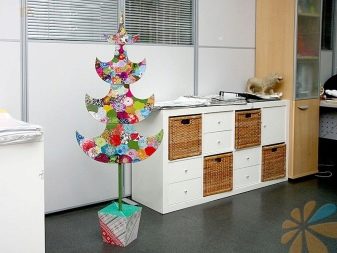Dekopatch is one of the interesting techniques of modern needlework. Today it is very popular among experienced craftsmen and novice craftswomen, contributing to the creation of bright and colorful products of various subjects. What is it, what are the pros and cons of technology, we will consider further.


What it is?
Dekopatch consider decoupage related technology which became known to the world thanks to the Italian cabinetmakers. At one time, they cut out pictures from paper and pasted them as decor, covered the pictures with varnish, which made the products expensive.
The meaning of decopatch is in pasting a three-dimensional figure with a convex or concave surface with pieces of napkins or other paper. The task of technology is volumetric decoration, creating a single background by sticking piece by piece.
This is a kind of decoration process that is used for papier-mâché figures or even furniture.


Features of the technique
The decopatch technique is unique and differs from decoupage in that it uses not individual fragments of decorative paper, but all the material. In view of this, there is no overspending of material and scraps - everything purchased is used. Pieces are torn off with hands or cut with curly scissors, and then glued to the working base with an overlap, preventing the formation of bald spots. In this case, the size of the torn fragments can be very different, if only they fit well on an uneven surface.
Glue paper with different adhesives. The technique is unique in that everything is suitable for it, whether it be special glue for decoupage, building PVA or acrylic varnish. Can be purchased for pasting and glue for decopatch.
It is possible to paste over this technique as part of the figure, as well as its entire surface.


Despite the fact that in the classical sense rectangular fragments of 2-3 cm are used for the decopatch, today this approach seems boring. But because the shape of the pieces can be very different. For example, you can glue objects with paper from cut triangles, mixing them with stripes, pentagons and even different patterns.
Performing work on this principle, you can create not only a single background, but also certain patterns and ornaments.


Advantages and disadvantages
This technique is unique and has many advantages. It allows you to create unique products that can become exclusive gifts for friends and relatives. For example, it can be a voluminous souvenir or craft in the form of a stylized kitten, dog, giraffe. This is a great way to decorate the interior of the room in ethnic style.
In addition, it can be a stand for jewelry, keys, phone. You can glue the usual box, figurine, flower pot, bottle or even a glass jar. In each case, a unique product will be obtained that will decorate the room in which it is located. We note briefly other advantages of the technique.
- For its implementation, you can use different materials and glue, which opens up a lot of opportunities for the manifestation of design ideas.
- It allows you to mask even the most unsightly foundation, giving it an aesthetic appeal and hiding the flaws of the work.
- With it, you can paste even the most complex forms with a sharp change in bend.
- There are no restrictions on the type of material to be glued, for example, a de-patch is used in work with bases of glass, wood, and fabric.


Technology has its drawbacks.
- It needs its own paper, rough paper is not suitable for this, it can be lifted and peeled off from the base.
- The process of sticking and preparing for it is quite lengthy. Such decoration takes a lot of time.
- The work does not tolerate haste and carelessness, as well as an abundance of glue due to the peculiarities of papier-mâché. If you overdo it with glue, you can deform the base.
- To increase the service life of the finished product, a protective coating is required, without it, the work can be damaged under the influence of moisture.


Paper selection
For decopatch use decorative paper. It can be, for example, napkins for decoupage, they are great for beginners, or even handmade paper. Today, on store shelves, you can buy paper specifically for de-patch.
From the usual paper for decoupage with characteristic thematic drawings for such a paper, the whole area is covered with a bright ornament or a certain pattern.
You can buy napkins with a solid pattern for background pasting (background wipes). Someone prefers to work with crepe paper, which is sold in stationery stores (in departments for children's creativity) and is often used in school for technology lessons. In fact, this is crumpled paper, which is also called corrugated paper or corrugated. It is thin and stretches wide, and when wet it becomes brighter, and requires accuracy.

See the masterclass on familiarizing yourself with the decopatch technique below.










